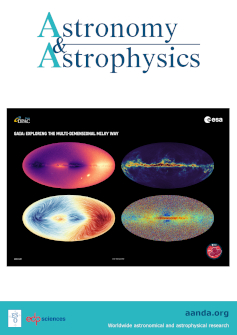第二代 "星链 "卫星发出明亮的非预期电磁辐射
IF 5.4
2区 物理与天体物理
Q1 ASTRONOMY & ASTROPHYSICS
引用次数: 0
摘要
我们报告了对第二代 "星链 "卫星非预期电磁辐射(UEMR)的探测结果。利用LOFAR射电望远镜在10至88 MHz和110至188 MHz之间进行的观测显示,v2-Mini和v2-Mini直达小区星链卫星发出的宽带辐射覆盖了40至70 MHz和110至188 MHz的频率范围。这种宽带 UEMR 的频谱功率通量密度因卫星而异,在 56 至 66 MHz 之间,其值从 15 到 1300 Jy 不等,在以 120 和 161 MHz 为中心的两个不同的 8 MHz 频率范围内,其值从 2 到 100 Jy 不等。我们将探测到的这种 UEMR 功率通量密度与第一代 v1.0 和 v1.5 Starlink 卫星发射的功率通量密度进行了比较。在对观测到的卫星距离进行校正后,我们发现第二代卫星发射的 UEMR 比第一代卫星强 32 倍。所探测到的 UEMR 的计算电场强度超过了商业电子设备所使用的典型电磁兼容标准以及国际电信联盟无线电通信部门(ITU-R)为保护射电天文学所分配的 150.05-153 MHz 频率范围而建议的发射阈值。我们描述了检测到的 UEMR 的特性,目的是协助卫星运营商查明 UEMR 的原因。本文章由计算机程序翻译,如有差异,请以英文原文为准。
Bright unintended electromagnetic radiation from second-generation Starlink satellites
We report on the detection of unintended electromagnetic radiation (UEMR) from the second-generation of Starlink satellites. Observations with the LOFAR radio telescope between 10 to 88 MHz and 110 to 188 MHz show broadband emission covering the frequency ranges from 40 to 70 MHz and 110 to 188 MHz from the v2-Mini and v2-Mini Direct-to-Cell Starlink satellites. The spectral power flux density of this broadband UEMR varies from satellite to satellite, with values ranging from 15 to 1300 Jy, between 56 and 66 MHz, and from 2 to 100 Jy over two distinct 8 MHz frequency ranges centered at 120 and 161 MHz. We compared the detected power flux densities of this UEMR to that emitted by the first generation v1.0 and v1.5 Starlink satellites. When correcting for the observed satellite distances, we find that the second-generation satellites emit UEMR that is up to a factor of 32 stronger compared to the first generation. The calculated electric field strengths of the detected UEMR exceed typical electromagnetic compatibility standards used for commercial electronic devices as well as recommended emission thresholds from the Radiocommunication Sector of the International Telecommunications Union (ITU-R) aimed at protecting the 150.05–153 MHz frequency range allocated to radio astronomy. We characterize the properties of the detected UEMR with the aim of assisting the satellite operator with the identification of the cause of the UEMR.
求助全文
通过发布文献求助,成功后即可免费获取论文全文。
去求助
来源期刊

Astronomy & Astrophysics
地学天文-天文与天体物理
CiteScore
10.20
自引率
27.70%
发文量
2105
审稿时长
1-2 weeks
期刊介绍:
Astronomy & Astrophysics is an international Journal that publishes papers on all aspects of astronomy and astrophysics (theoretical, observational, and instrumental) independently of the techniques used to obtain the results.
 求助内容:
求助内容: 应助结果提醒方式:
应助结果提醒方式:


